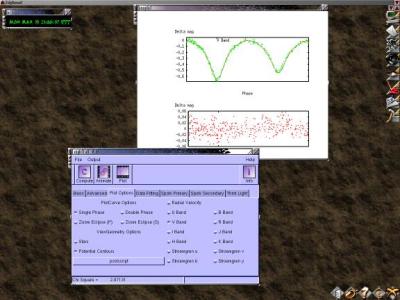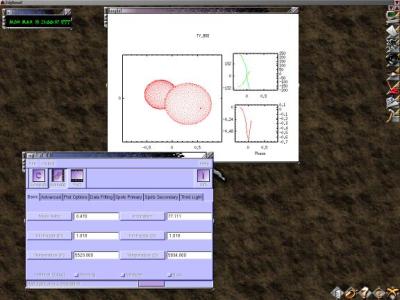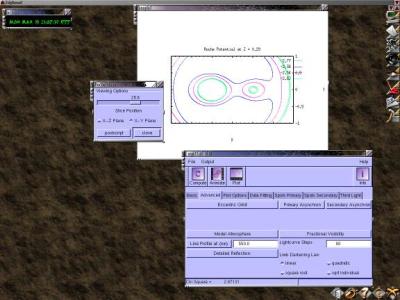Nightfall
Nightfall is an astronomy application for fun, education, and science. It can produce animated views of eclipsing binary stars, calculate synthetic lightcurves and radial velocity curves, and eventually determine the best-fit model for a given set of observational data of an eclipsing binary star system. It is, however, not able to fry your breakfast egg on your harddisk. Nightfall comes with a user guide, and a set of observational data for several eclipsing binary star systems. New: It is possible now to load filter definitions (limb darkening coefficients, model atmosphere fluxes) for arbitrary filters from user supplied files.
The screenshots show a lightcurve of the eclipsing binary star TY Boo (left), a snapshot of the animated simulation of the same star (middle), and the interactive Roche potential display (right).
New: MPEG movie of OpenGL animation: output.mpg (300 kB)
Details
Nightfall is a mildly ultramundane code of baroque complexity (I like Verdi and Haendel on lazy sunday mornings - friday evenings are better with Iron Maiden and a good whisky). Nightfall is based on a physical model that takes into account the nonspherical shape of stars in close binary systems, as well as mutual irradiance of both stars, and a number of additional physical effects.
Nightfall can handle a large range of binary star configurations, including overcontact (common envelope) systems, eccentric (non-circular) orbits, surface spots and asynchroneous rotation (stars rotating slower or faster than the orbital period), and the possible existence of a third star in the system ('third light').
Nightfall is distributed under the terms of the GNU Public License and comes without any warranty.
Refereed papers where Nightfall is used:
Covino et al. 2000, Astron. Astrophys. 361, L49
Sandquist et al. 2003, Astron. J. 125, 810
Sandquist & Shetrone 2003, Astron. J. 125, 2173
Sandquist & Shetrone 2003, Astron. J. 126, 2954
Covino et al. 2004, Astron. Astrophys. 427, 637
Drake & Cook 2004, Astrophys. J. 604, 379
Soszynski et al. 2004, Acta Astron. 54, 347
Creevey et al. 2005, Astrophys. J. 625, L127
Selam et al. 2005, Ap&SS 296, 305
Nagel et al. 2006, Astron. Astrophys. 448, L25
Martins et al. 2006, Astrophys. J. 649, L103
Austin et al. 2007, Astron. J. 133, 1934
Prieto et al. 2008, Astrophys. J. 673, L59
Clarkson et al. 2011, Astrophys. J.
Mahy et al. 2011, Astron. Astrophys.
For information on binary star programs for Windows or MacOS, see Dan Bruton's Eclipsing Binary Stars web site
The special gift: Your "Star" in the sky ! (page in German)
Download
Source code: nightfall-2.0.1.tar.gz (1.7 MB - includes many observational data to experiment with).
signature: nightfall-2.0.1.tar.gz.sig.
For bug reports please use the contact form, or send mail to support@la-samhna.de
Installation
gunzip -c nightfall-2.0.1.tar.gz | tar -xvf - cd nightfall-2.0.1/ ./DoInstall.sh
DoInstall.sh is an interactive shell script to guide you through the installation. If you prefer to do it by hand, use the following sequence of commands:
gunzip -c nightfall-2.0.1.tar.gz | tar -xvf - cd nightfall-2.0.1/ ./configure make make install
In case of configure/compile related questions or problems, please read the corresponding section in the README file. If you still cannot solve the problem, don't hesitate to contact me - and don't forget to attach the output of configure (and make, eventually), as well as the following files: config.log, config.status, config.cache.
Requirements
Linux (or any other Unix), the GTK+ library (included in most Linux distributions), and the GNUPLOT plotting program (also included in most Linux distributions).
If you have GNOME, Nightfall will compile with support for it, but GNOME is not required to compile and run Nightfall.
For OpenGL support, you need OpenGL or MesaGL, as well as the gtkglarea library.
Instead of GNUPLOT, you can also use the PGPLOT graphics subroutine library (not GPL, but free for non-commercial use). You will need a FORTRAN compiler to compile PGPLOT (g77 is fine). Precompiled binaries are available on the 'Linux for Astronomy' CD-ROMs and for Debian GNU/Linux. Animated mode flickers with PGPLOT, runs smoother with GNUPLOT.
Note: Nightfall needs neither GNUPLOT/PGPLOT nor GTK+ to compile and run, but it is pretty boring without graphics ...



